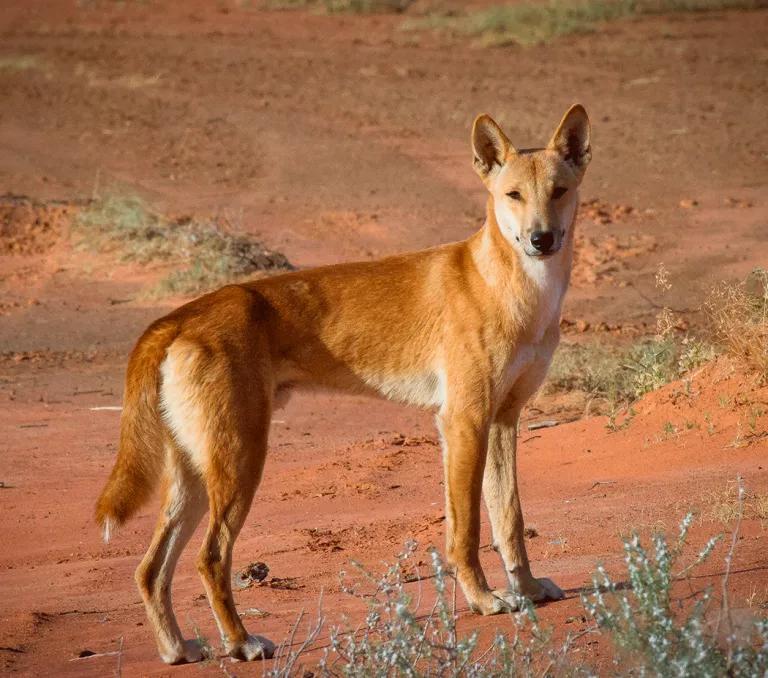A Dingo Ate My Bunny!
Scientists say reintroducing invasive-eating dingoes could have big benefits for Australia’s endangered animals.

Australia boasts the longest fence in the world—It’s more than 3,400 miles long, 6 feet high, and cobbled together with high wire mesh, electric fencing, and cattle grids. End to end, there’s enough fence to stretch from Miami to Seattle and then some.
What possessed the Aussies to build their very own Great Wall?
In a word: dingoes.
The dingo (Canis lupus dingo) has been Australia’s apex predator for roughly the last 3,000 years. Like their closest relative, the gray wolf, these wild dogs can take down prey many times their size by hunting in packs. In the wild, they hunt kangaroos, wallabies, wombats, and rabbits. But every once and a while, they take down livestock.
And that’s why the continent’s pastoralists began fencing dingoes out of southeastern Australia as early as 1880. (They also shot and poisoned them.) Many other fences have since been connected and reinforced, forming a nearly coast-to-coast pest barrier unlike anything else in the world.
They call it the dingo-proof fence, though parts of it are also called the rabbit-proof fence. It keeps invasive bunnies in, preventing them from spreading north into the wild. It also blocks emus and many other species, as this now-iconic image shows. (Suffice it to say, dingoes are just one of many wildlife issues in Australia.)
“The fence has essentially created two ecological universes, one with dingoes, one without,” says Thomas Newsome, a postdoctoral research assistant in the Desert Ecology Research Group at the University of Sydney.
Newsome recently published an article in the journal Restoration Ecology arguing that keeping dingoes out of the south may be harming the ecosystem there.
For example, the dingo’s absence has allowed smaller predators like invasive red foxes and feral cats to prosper. These “mesopredators” make a living by eating some of Australia’s most endangered critters, like the impossibly cute greater bilby and burrowing bettong. (Australian animals have the best names.)

And as we’ve seen in the United States, with the reintroduction of wolves into Yellowstone National Park, allowing apex predators recolonize former habitats may have ripple effects throughout the ecosystem.
“Without control or regulation by dingoes, kangaroos and other large herbivores can contribute to rangeland degradation,” says Newsome. The dingoes eat the herbivores, which cuts down on overgrazing and allows for more food and ground cover for native species.
As with the gray wolf, the debate over dingoes has been raging for at least 20 years. Livestock owners accuse the dingo of eating half a million sheep between 2008 and 2011. (A rancher in that article dubiously claims dingoes chase sheep, “eat the kidney out of it and just leave it to die.”) Others say they are simply misunderstood and keep the animals as pets. And, of course, a coroner just recently decided that a dingo did, in fact, eat baby Azaria Chamberlain in 1980.
But it’s not as if Newsome is now calling for a total dismantling of the fence. (Though plenty of environmentalists are asking Mr. Prime Minister to tear down that wall.)
Instead, he and his coauthors propose that a small section—about 170 miles—be rerouted to include Sturt National Park. The park, which is about an 18-hour drive from Sydney, already has dingo fencing across its northern border. If it were realigned to the southern border, dingoes could recolonize the area from the north—the effects of which Newsome would love to study.

Although dingoes might have a positive effect on the food web, introducing species can have unintended and sometimes unwanted consequences. Saving the bald eagle from extinction may have had a negative impact on seagulls, for instance. Playing devil’s advocate, I asked Newsome what the worst-case scenario would be if dingoes return to Sturt National Park.
“Australia’s rate of mammal extinction cannot get much worse,” he replied. The continent has already lost 29 endemic mammals, and a further 21 percent are threatened. Invasive red foxes and feral cats play a big role in these extinctions, he says, and both currently inhabit the park.
“Thus, there is no worst-case scenario," he said. "We can only learn from what happens when dingoes return to Sturt National Park.”
But won’t all that fence rejigging cost money? Yes siree, mate!
Newsome and company estimate all that new fencing and eight years of monitoring the ecosystem will cost about $7 million. Sounds like a lot for a dingo study—until you consider how Aussies spent almost $15 million in 2010 to mitigate the damage that feral camels have caused in the outback, and have dished out $4.2 million a year since 2002 to eradicate red foxes from Tasmania.
So I reckon it’s time to stop debating and start investigating. In other words, release the hounds!

This article was originally published on onEarth, which is no longer in publication. onEarth was founded in 1979 as the Amicus Journal, an independent magazine of thought and opinion on the environment. All opinions expressed are those of the authors and do not necessarily reflect the policies or positions of NRDC. This article is available for online republication by news media outlets or nonprofits under these conditions: The writer(s) must be credited with a byline; you must note prominently that the article was originally published by NRDC.org and link to the original; the article cannot be edited (beyond simple things such grammar); you can’t resell the article in any form or grant republishing rights to other outlets; you can’t republish our material wholesale or automatically—you need to select articles individually; you can’t republish the photos or graphics on our site without specific permission; you should drop us a note to let us know when you’ve used one of our articles.

These 5 Animals Would Be Goners Without the Endangered Species Act
Finally, a High Seas Treaty to Protect the World’s Oceans
Can Anything Be Done to Stop Overfishing?